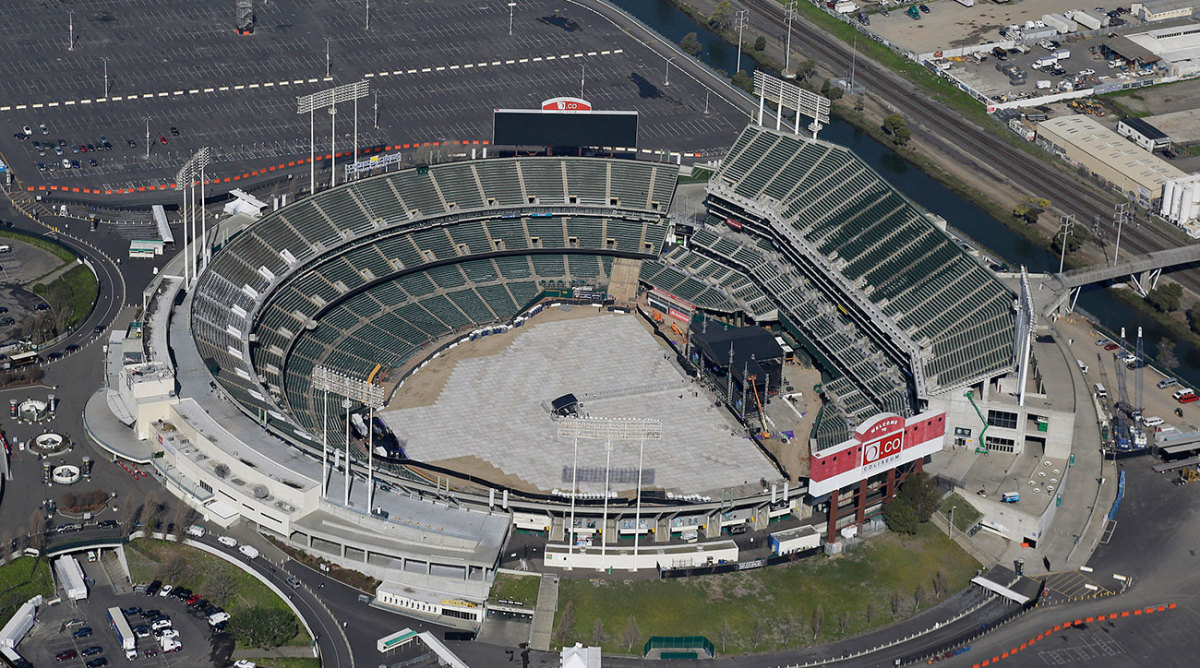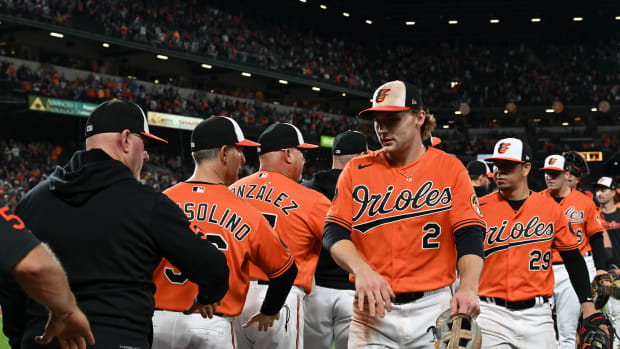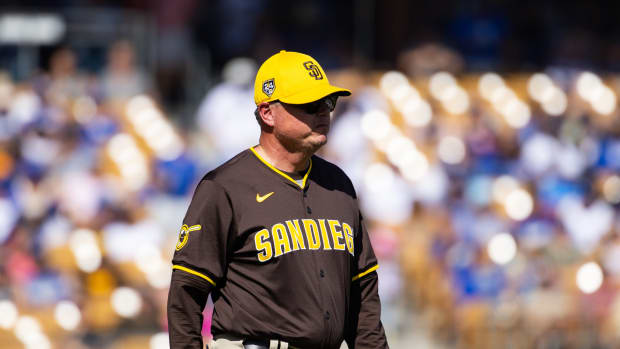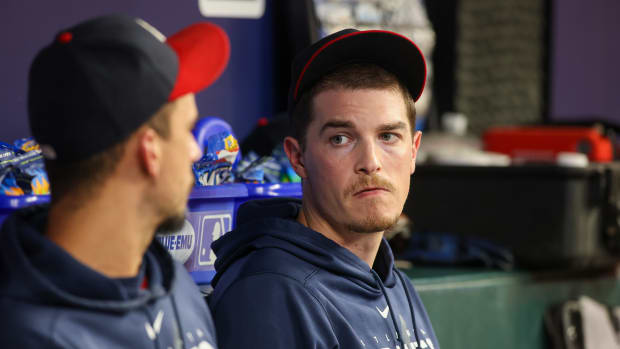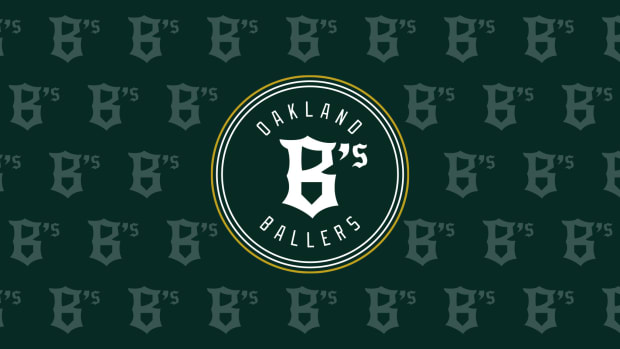Winter Report Card: Biggest change for Athletics comes off the field
Before pitchers and catchers report to spring training, we’re checking in to see how each team has fared thus far this off-season, acknowledging that there’s still time for that evaluation to change. Teams will be presented in reverse order of finish from 2016. Next up: the Oakland Athletics.
2016 Results
69–93 (.426), fifth place in American League West
Key Departures
IF/OF Arismendy Alcantara, RHP Ross Detwiler*, IF/OF Danny Valencia
Key Arrivals
RHP Paul Blackburn, RHP Santiago Casilla, OF Rajai Davis, RF Matt Joyce, 3B Trevor Plouffe
(*free agent, still unsigned)
Off-season In Review
After three straight postseason appearances from 2012 to '14, the A's ground through their second dismal season in a row in '16, though unlike the year before—when Billy Beane and company fancied the team as contenders even in the wake of the Josh Donaldson and Jeff Samardzija trades—expectations were far lower. Based on what they've done this winter, they shouldn't be a whole lot higher for 2017, though the big news is that a shakeup in ownership and changes within the new Collective Bargaining Agreement carry significant long-term ramifications. Most notably, managing partner Lew Wolff, who drove the team's quest to build a new stadium in nearby Fremont or San Jose, is out, as is president Mike Crowley, with John Fisher and Dave Kaval taking over their respective roles. With that comes a shift toward attempting to build a privately-funded stadium in Oakland. The new ballpark is a necessity, not only because the Coliseum (by whatever name they're calling it) is so dilapidated but also because the new CBA phases the A's out of revenue sharing—which brought in $35 million last year—by 2021. They'll need the revenue from the new park to offset that.
In light of that, the focus this winter has been on short-term moves that won't compromise the club's long-term outlook, and to that end, the lineup has been patched up, albeit in ways that have more upside than the usual holding-pattern moves. The biggest move has been the signing of Joyce to a two-year, $11 million deal. The 32-year-old lefty hit an impressive .242/.403/.463 with 13 homers in 293 plate appearances for the Pirates after tweaking his swing mechanics and will take over rightfield, where the departed Valencia—more on whom momentarily—handled most of the work after Josh Reddick was dealt to the Dodgers at the trade deadline.
Davis, who signed a one-year, $6 million deal that includes some modest incentives, will be the primary centerfielder, a job he filled in Oakland from 2008 to '10. The 36-year-old righty spent last year with the Indians, hitting .249/.306/.388 with 12 homers and an AL-high 43 steals. While he hit better against righties than lefties in 2016, he's generally struggled against same-siders and could use less exposure; even so, it would be difficult not to improve upon the .235/.295/.324 showing the team got from Billy Burns, Coco Crisp (both since departed), Brett Eibner and Jake Smolinski at the position.
MLB's top 10 storylines of 2017, from Indians and Cubs to the World Baseball Classic
The exact terms of Plouffe's one-year deal aren't clear yet, but it's reportedly worth around $5 million plus incentives. The 30-year-old third baseman hit just .260/.303/.420 with 12 homers last season but was limited to 84 games by a slew of injuries (intercostal, oblique and groin strains, a knee sprain and a cracked rib). He'll be the regular at the hot corner, with 2016 rookie surprise Ryon Healy, who bopped 13 homers and hit .305/337/.524 in 72 games, shifting to designated hitter and first base duty.
The other big addition via free agency is the return of Casilla, who spent 2004–09 with the A's—some of that time spent playing under the name Jairo Garcia. Casilla saved 31 games with the Giants last year but fell out of Bruce Bochy's favor and lost the closer's job in September after blowing nine saves. While his 10.1 strikeouts-per-nine rate was a career high, his 3.57 ERA was his worst mark since 2009. He'll likely pair with Sean Doolittle as a setup man in front of closer Ryan Madson, but at some point during his second go-round in the green-and-gold, he could eventually get save opportunities that would boost his value in trade.
The biggest loss from the 2016 roster—aside from the already-departed Reddick, Rich Hill, Crisp, Billy Butler and so on—is that of Valencia, who was one of Oakland's most productive hitters (.287/.346/.446 with 17 homers) while spending time at first and third base. He was also apparently a clubhouse problem who wore out his welcome, and not for the first time. A pending free agent, he was dealt to the Mariners for Blackburn, a 2012 supplemental first-round pick who split his season between the Double A affiliates of the Cubs and Mariners, posting a 3.27 ERA with 6.2 strikeouts per nine. He could get a second-half look at the back of a rotation with no clear fifth starter behind Sonny Gray, Sean Manaea, Jharel Cotton and Kendall Graveman.
New Year's Resolutions: What each American League team should do in 2017
Unfinished Business: Sign Mark Trumbo, rebuild the value of Gray
The A's made a run at Edwin Encarnacion before he signed with the Indians, reportedly offering the slugger either a straight two years and $50 million or a two-plus-option contract with an opt-out as well. Given the currently depressed market for sluggers, it's not a bad idea to see if Oakland can sign Trumbo, who led the AL with 47 homers and hit .256/.316/.548. Team after team has made the mistake of viewing the now-31-year-old slugger as an outfielder despite the fact that he's a terrible one, costing his teams 23 runs over the past three seasons according to Defensive Runs Saved. However, he's a serviceable first baseman (+4 DRS in 371 career games) and far more productive than incumbent Yonder Alonso (.253/.316/.367 with seven homers in 2016).
Trumbo is reported to have asked Baltimore for a three-year, $40 million deal after rejecting one that was said to be for four years and over $50 million. While he did receive a qualifying offer, the A's have a protected first-round pick and thus would only lose their second rounder. With him in the lineup and paired with 42-homer slugger Khris Davis along with a full season of Healy, the arrival of Joyce, improvement in centerfield and bouncebacks from Plouffe, Gray and a couple others, it's not hard to envision a much more competitive team than the A's fielded in 2016. And since it's Oakland's way, at some point it's likely that Trumbo would be dealt somewhere else for younger, club-controlled players.
That's the glass-half-full scenario. On the other hand, it's entirely possible to look at this roster and see another squad that will win fewer than 70 games, particularly if Beane and general manager David Forst don't make further improvements. Either way, Oakland's long-term outlook would be improved significantly with a rebound from Gray, who was lit up for a 5.69 ERA and limited to 22 starts and 117 innings due to forearm inflammation; his home run rate doubled from 0.7 per nine to 1.4, and his walk rate rose as well. He's now in the first year of arbitration eligibility, and assuming that the A's don't ink him to a long-term deal, he'll be traded sometime in the next 2 1/2 years. Given the dearth of frontline starters on the market and the lack of game-changing prospects within Oakland's system, the A's really need the 27-year-old righty to recover his 2013–15 form, though that’s not really something that can happen before Opening Day.
Preliminary Grade: C+
The A's haven't made any big moves this winter, roster-wise, but the ones they did make have some upside even if the team as a whole doesn't recover enough to contend. More importantly, the change in upper management means a new ballpark is finally in the franchise's grasp, which should provide an off-ramp from the treadmill that the team has occupied for so long.






























